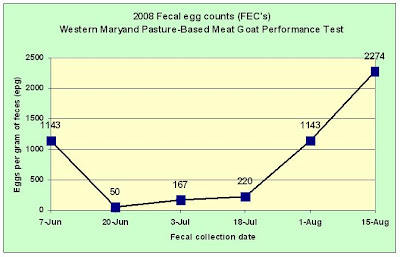For the August 15 collection date, invididual fecal egg counts ranged from 0 to 12,400 eggs per gram (epg). The average was 2,274 epg as compared to 1,143 epg on August 1 and 220 epg on July 18. For the two samples collected in August, average fecal egg counts range from 0 to 6,634 for an average of 1,721 for the 59 goats with data.
At the same time, there are several goats in the test that continue to have low egg counts and have yet to require deworming.
 If a goat is dewormed within 14 days prior to the fecal collection, the resulting fecal data is not an indication of parasite resistance, but rather a measure of the effectiveness (or resistance) of the anthelmintic treatment. Moxidectin has been used on goats that have required deworming.
If a goat is dewormed within 14 days prior to the fecal collection, the resulting fecal data is not an indication of parasite resistance, but rather a measure of the effectiveness (or resistance) of the anthelmintic treatment. Moxidectin has been used on goats that have required deworming.Download latest FEC report











